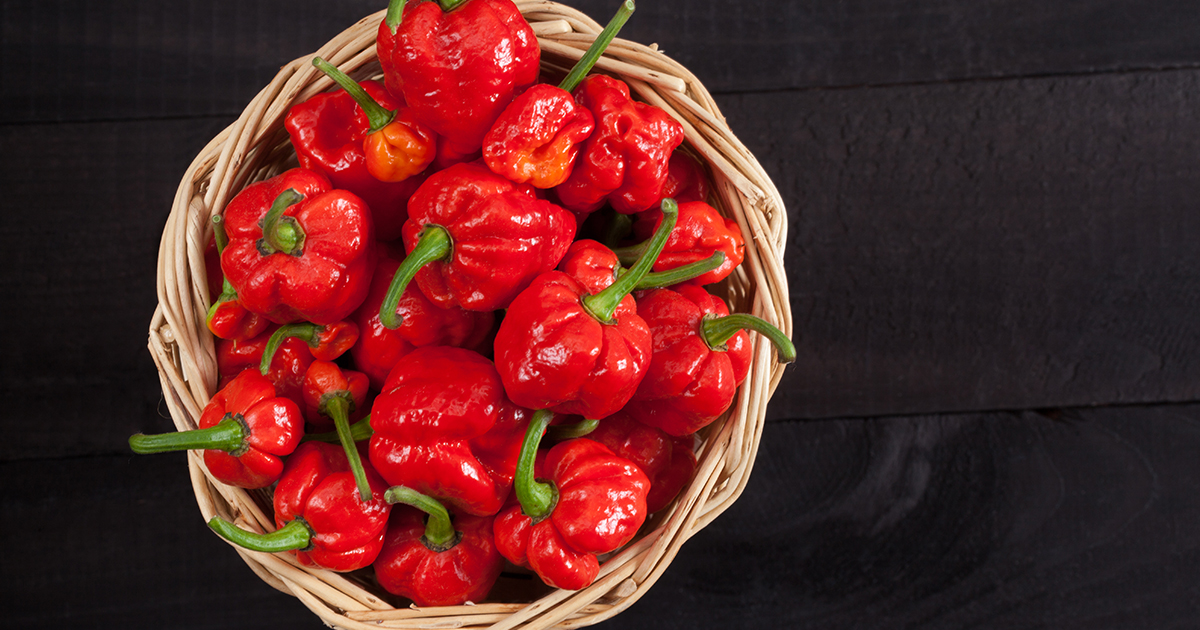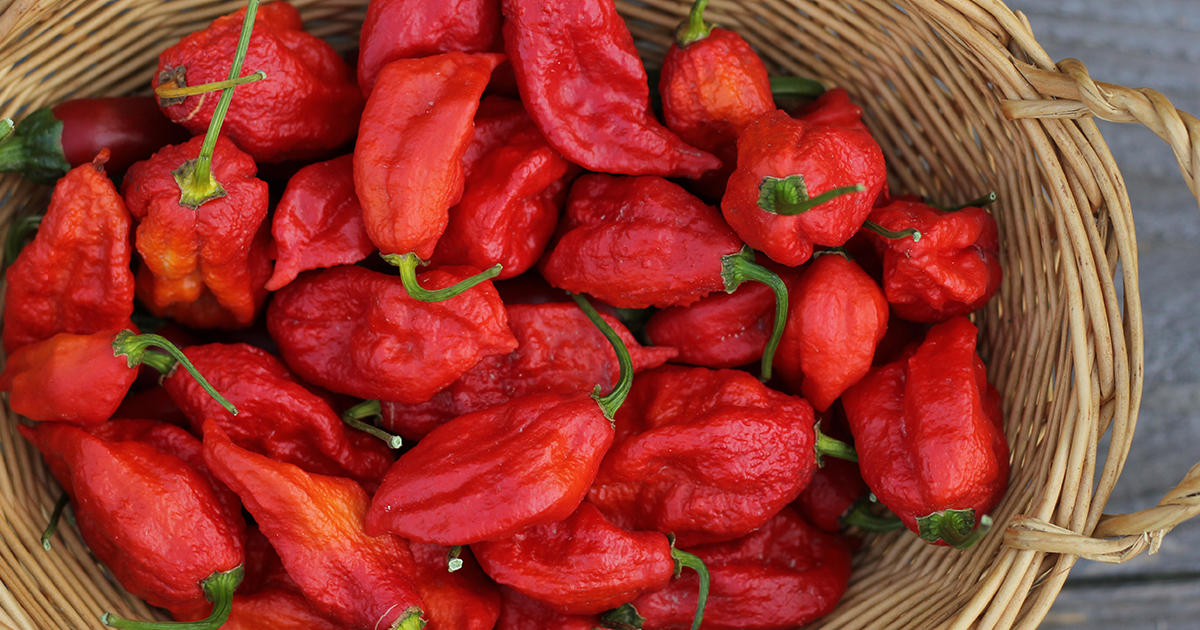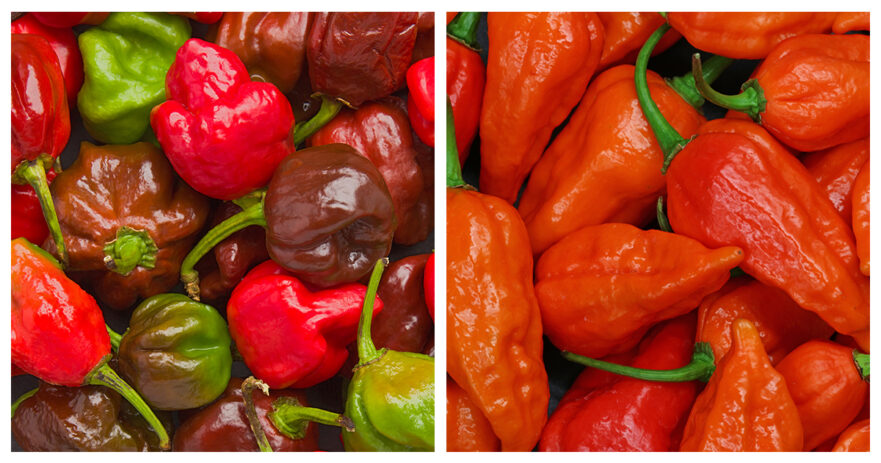Are you a spice enthusiast looking to push your limits with the hottest peppers in the world? Look no further than the scorpion pepper and the ghost pepper. These two peppers are renowned for their extreme heat levels, with both having been hailed as the hottest in the world for a time. But which one is hotter? In this article, we’ll dive deep into the unique qualities of the scorpion pepper and ghost pepper, helping you decide which one is right for you.
| Trinidad Moruga scorpion pepper | Ghost pepper | |
| SHU | 1,200,000 - 2,000,000 | 855,000 - 1,041,427 |
| Median SHU | 1,600,000 | 948,214 |
| Flavor | Sweet and fruity | Fruity and slightly sweet, with a very intense heat |
| Species | Capsicum chinense | Hybrid of Capsicum chinense x Capsicum frutescens |
| Origin | Trinidad and Tobago | Northern India |
| Uses | Hot sauces, marinades, and as a seasoning | Hot sauces, salsas, curries, pickling, etc. |
Table of contents
What is the Scorpion Pepper?

The scorpion pepper, also known as Trinidad Moruga Scorpion, is a variety of chili pepper originally from Trinidad and Tobago. This pepper snagged the title of the world’s hottest pepper in 2012 with an average Scoville rating of 1.2 million, though some individual peppers have been known to reach up to 2 million SHU. To put that in perspective, the average jalapeño has a rating of 2,500 to 8,000 Scoville units.
The scorpion pepper is a small, wrinkled pepper that starts out green and matures to a bright red color. It has a fruity, slightly sweet flavor that gives way to an intense, lingering heat that can last up to minutes. This pepper is definitely not for the faint of heart and should be used very sparingly in dishes.
Despite its extreme heat, the scorpion pepper has gained immense popularity among chili pepper enthusiasts and hot sauce makers. Its unique flavor and heat make it a great addition to dishes like chili, sauces, and marinades.
In recent years, the popularity of hot peppers like the scorpion pepper has led to the creation of various food challenges and eating contests. These challenges often involve trying to consume large quantities of extremely hot peppers or hot sauces with the singular goal of lasting the longest or finishing the fastest. While these challenges can be entertaining to watch, it’s important to remember that consuming large amounts of hot peppers can be dangerous and potentially harmful to your health, so play carefully.
What is the Ghost Pepper?

The ghost pepper, also known as the bhut jolokia, is a chili pepper native to Northeast India. For a time, it held the title of world’s hottest pepper with an average Scoville rating of 1,001,000. However, it‘s since been surpassed by peppers like the scorpion pepper and Carolina Reaper.
The ghost pepper is a small, bumpy little guy that starts off green and matures to a bright red or orange color. It has a sweet, fruity flavor that gives way to some serious heat. This pepper is used in a lot of Indian cuisines, and it‘s a common ingredient in curries and chutneys.
Despite its extreme heat, the ghost pepper has gained popularity worldwide, especially with hot sauce makers incorporating it into their products. Its unique flavor and heat make it a phenomenal addition to things like chili, sauces, and marinades.
What are the Differences Between Scorpion Peppers and Ghost Peppers?
While the scorpion pepper and ghost pepper are both incredibly popular among pepper enthusiasts for their spice levels, there are some serious differences between them that you should to keep in mind.
Let’s start off with something easy: heat levels. The scorpion pepper has a higher average Scoville rating than the ghost pepper, 1.2 million versus 1 million. However, individual peppers can vary greatly in heat.
In terms of how they’re used, both peppers ought to be used sparingly due to their intense heat. However, the scorpion pepper is often used in very small quantities to add a kick of heat to various dishes, while the ghost pepper is often used in more complex dishes such as curries or stews.
While the scorpion pepper and ghost pepper may seem like they can be interchangeable since they both have high heat levels, it’s important to remember that the scorpion pepper has a higher level of capsaicin, which is the chemical responsible for the pepper’s heat. This means that the scorpion pepper can create a more intense, longer-lasting heat than the ghost pepper.
What are the Similarities Between Scorpion Peppers and Ghost Peppers?
While the scorpion pepper and ghost pepper do have their differences, they also happen to share many similarities. Both peppers are renowned around the world for their spicy kicks, making them a favorite of pepper enthusiasts and hot sauce makers alike.
Firstly, both the scorpion pepper and the ghost pepper have unmistakable appearances. They‘re both small, wrinkled peppers that start out green and mature to a bright red color. They‘re also both incredibly hot, with an average Scoville rating of over 1 million.
Secondly, both the scorpion pepper and ghost pepper are wonderfully versatile ingredients that can be used in a variety of dishes. While they‘re most commonly associated with spicy foods, they can also be used in marinades and rubs to add a hit of flavor to meats and vegetables.
Both peppers are also used to create hot sauces, and each pepper provides its own to the final product. Some hot sauce makers even combine the two peppers to create a balanced, yet incredibly fiery sauce. Some wild folks even like to use them to make scorpionspice-infused cocktails or desserts!
Thirdly, both peppers require absolute caution when handling and cooking. The capsaicin in both peppers can easily cause skin irritation and burns, and their heat can quickly overpower a dish if not measured carefully.
Finally, the scorpion pepper and ghost pepper are both highly sought after by those who love a good heat challenge! Both peppers have made headlines for being some of the hottest peppers in the world, and tons of people enjoy trying them out to see just how much heat they can handle.
FAQ about Scorpion Pepper and Ghost Pepper
Which pepper is hotter, the scorpion pepper or the ghost pepper?
On average, the scorpion pepper is going to be hotter than the ghost pepper, with a Scoville rating of 1.2 million to 2.0 million, compared to the ghost pepper's 1 million. Individual peppers can vary, though.
Are scorpion peppers and ghost peppers interchangeable in recipes?
While both peppers are incredibly hot, they have some differences in terms of their usage. The scorpion pepper is going to be hotter, so you may want to use it a little less.
What are the similarities between scorpion peppers and ghost peppers?
Both are small and wrinkled peppers that mature to a bright red color. They‘re incredibly hot, with an average Scoville rating of over 1 million. Additionally, those who enjoy a good heat challenge are after both peppers.
What are the differences between scorpion peppers and ghost peppers?
While both peppers are known for their extreme heat, the scorpion pepper has a higher level of capsaicin. This means that the scorpion pepper can cause a more intense and longer-lasting heat than the ghost pepper. They’re also often used in different ways in recipes.
Can consuming large amounts of scorpion pepper or ghost pepper be bad for your health?
Yes, consuming large amounts of hot peppers can potentially be harmful to your health, especially your stomach. We recommend small doses, delicious though they may be.
Are scorpion peppers and ghost peppers commonly used in hot sauces?
Absolutely, both peppers can be used to create hot sauces, and each pepper can provide a unique flavor and level of heat to the final product.
What types of dishes can scorpion peppers and ghost peppers be used in?
Both peppers can be used in a variety of dishes, such as chili, sauces, and marinades. They can also be used in all manner of meat dishes, roasted veggies, etc.

